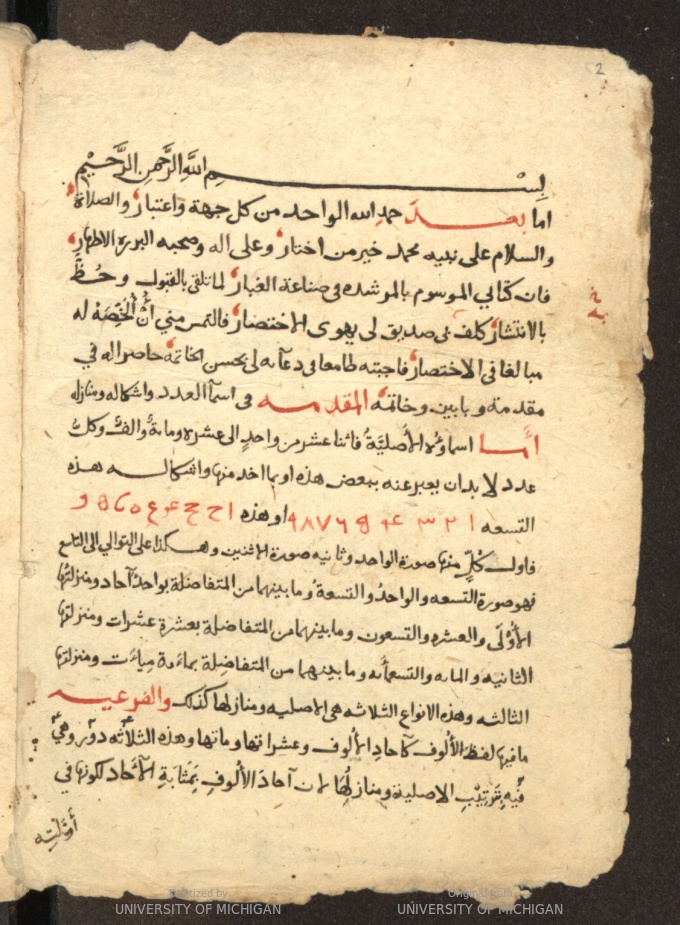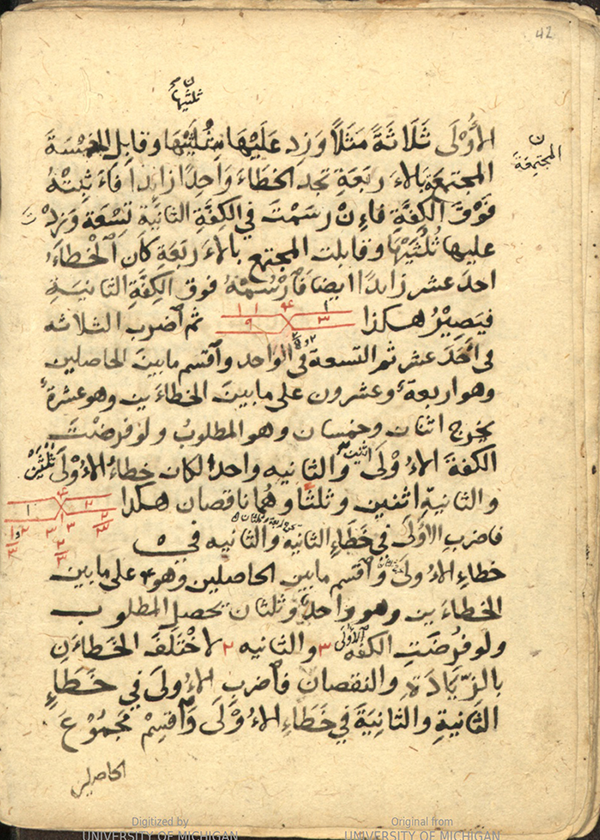- About MAA
- Membership
- MAA Publications
- Periodicals
- Blogs
- MAA Book Series
- MAA Press (an imprint of the AMS)
- MAA Notes
- MAA Reviews
- Mathematical Communication
- Information for Libraries
- Author Resources
- Advertise with MAA
- Meetings
- Competitions
- Programs
- Communities
- MAA Sections
- SIGMAA
- MAA Connect
- Students
- MAA Awards
- Awards Booklets
- Writing Awards
- Teaching Awards
- Service Awards
- Research Awards
- Lecture Awards
- Putnam Competition Individual and Team Winners
- D. E. Shaw Group AMC 8 Awards & Certificates
- Maryam Mirzakhani AMC 10 A Awards & Certificates
- Two Sigma AMC 10 B Awards & Certificates
- Jane Street AMC 12 A Awards & Certificates
- Akamai AMC 12 B Awards & Certificates
- High School Teachers
- News
You are here
Mathematical Treasure: The Method of the Scales in ibn al-Ha’im’s ‘Book of Delights’
The first page of a manuscript copy of Kitāb al-nuzah (or Book of Delights), a work in Arabic by Aḥmad ibn Muḥammad, known as ibn al-Hāʾim, who was born in Cairo in 1352 and died in Jerusalem in 1412, is shown below. This copy was written in 1506 or 1507. The very top line (between the two triads of red dots) reads, from right to left: “Kitāb al-nuzah li-ibn al-Hā’im” (Book of Delights of ibn al-Hā’im). The writing in red, called rubrication, was a medieval technique for highlighting important elements of a manuscript. It was generally written by specialized scribes known as rubricators. On this and numerous other pages of this copy of the manuscript, one or more readers wrote comments in the margins.

On the second page of the manuscript, shown below, the decimal digits are introduced in red. Reading line 10 from right to left, two different forms of the digits 1-9 are given in red. A dot or small circle, not shown here, was the Indo-Arabic symbol for zero.

On the page below, the Rule of Double False Position is discussed. In Arabic, falsehood = al-khaṭāʾ, a word visible at the very end (far left) of line 4. In North Africa, the method was more widely known as the Method of the Scales because of the scale (balance) diagram that was traditionally used in this region to help organize the numbers involved in the calculation; two instances of the scale diagram are drawn in red on this page. In Arabic, scale = al-kiffah, a word seen near the end of line 5.

On the page above, reading the third line from the bottom from right to left, the first red figure is the number \(3\) and the second the number \(2.\) In the second of the two scales diagrams, two instances of the fraction \(\frac{2}{3}\) can be read.
The two scales diagrams here correspond to two different ways to solve the following problem:
Find the unknown amount which, when increased by two-thirds of itself, is \(4.\)
In both diagrams, the digit \(4\) is written at the top of the balance, which is called the qubba or “dome”. (In many similar manuscripts, the dome was drawn as such, a semicircular arc pointing downward, but here the arc is omitted.)
The first diagram shows an example involving two guesses that both lead to “excesses”. If we try the number \(9,\) then we get \(9 + \frac{2}{3}\cdot 9 = 15,\) which is \(11\) more than \(4;\) if we try the number \(3,\) then we get \(5,\) which is \(1\) more than \(4.\) The two suppositions, \(9\) and \(3,\) can be seen written on opposite sides of the scale, with the corresponding excesses, \(11\) and \(1,\) above them. Now for the calculation: Because \(3\times 11 - 9\times 1 = 24,\) and \(11 - 1 = 10,\) the number sought is \(24\div 10,\) or \(2\frac{2}{5}.\)
The second diagram shows an example involving two guesses that both lead to “deficits”. If we try the number \(1,\) then we get \(1\frac{2}{3},\) which is \(2\frac{1}{3}\) less than \(4;\) if we try the number \(2,\) then we get \(3\frac{1}{3},\) which is \(\frac{2}{3}\) less than \(4.\) The two suppositions, \(1\) and \(2,\) can be seen written on opposite sides of the scale, with the corresponding deficits, \(2\frac{1}{3}\) and \(\frac{2}{3},\) below them. Now for the calculation: Because \(2\times 2\frac{1}{3} - 1\times \frac{2}{3} = 4,\) and \(2\frac{1}{3} - \frac{2}{3} = 1\frac{2}{3},\) the number sought is \(4\div 1\frac{2}{3},\) or \(2\frac{2}{5}.\)
A third variant of the method of scales was used in the case of “one excess and one deficit”, but no example is given in this manuscript. It should also be noted that while the problem solved here is strictly linear — in modern notation, it might be written \(x + \frac{2}{3}x = 4\) — the method of double false position was also routinely applied to affine linear problems of the form \(ax + b = c,\) where \(c\) is given explicitly, but \(a\) and \(b\) are only implicit.
For two more examples, from the work of Aḥmad ibn al-Bannāʾ (1256-1321), of problems solved by the method of scales (double false position), see:
Berggren, J. Lennart, “Chapter 3. Mathematics in the Islamic World in Medieval Spain and North Africa,” in Victor J. Katz (ed.), Sourcebook in the Mathematics of Medieval Europe and North Africa, Princeton University Press, 2016, pp. 410-412.
To learn how to read fractions from the Maghreb (Islamic North Africa) from this era, see the Convergence article, Moses ibn Tibbon’s Hebrew Translation of al-Hassar's Kitāb al Bayān, by Jeremy I. Pfeffer.
The images above were obtained through the courtesy of the University of Michigan Libraries. The full manuscript is available via the HathiTrust Digital Library as
Record 002563048: "Kitāb al-nuzhah : manuscript, [1506 or 07?] / li-ibn Hāyim"
[which should begin and end "Kitāb al-nuzah ... li-ibn al-Hā’im” (Book of Delights ... of ibn al-Hā’im)].
Randy K. Schwartz (Schoolcraft College) and Frank J. Swetz (The Pennsylvania State University), "Mathematical Treasure: The Method of the Scales in ibn al-Ha’im’s ‘Book of Delights’," Convergence (May 2017)




